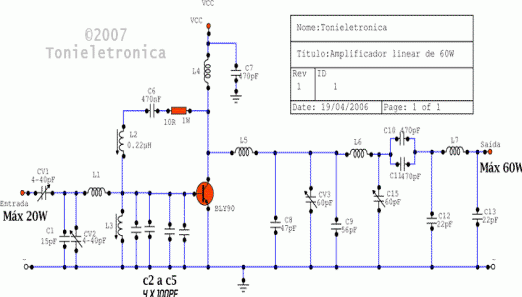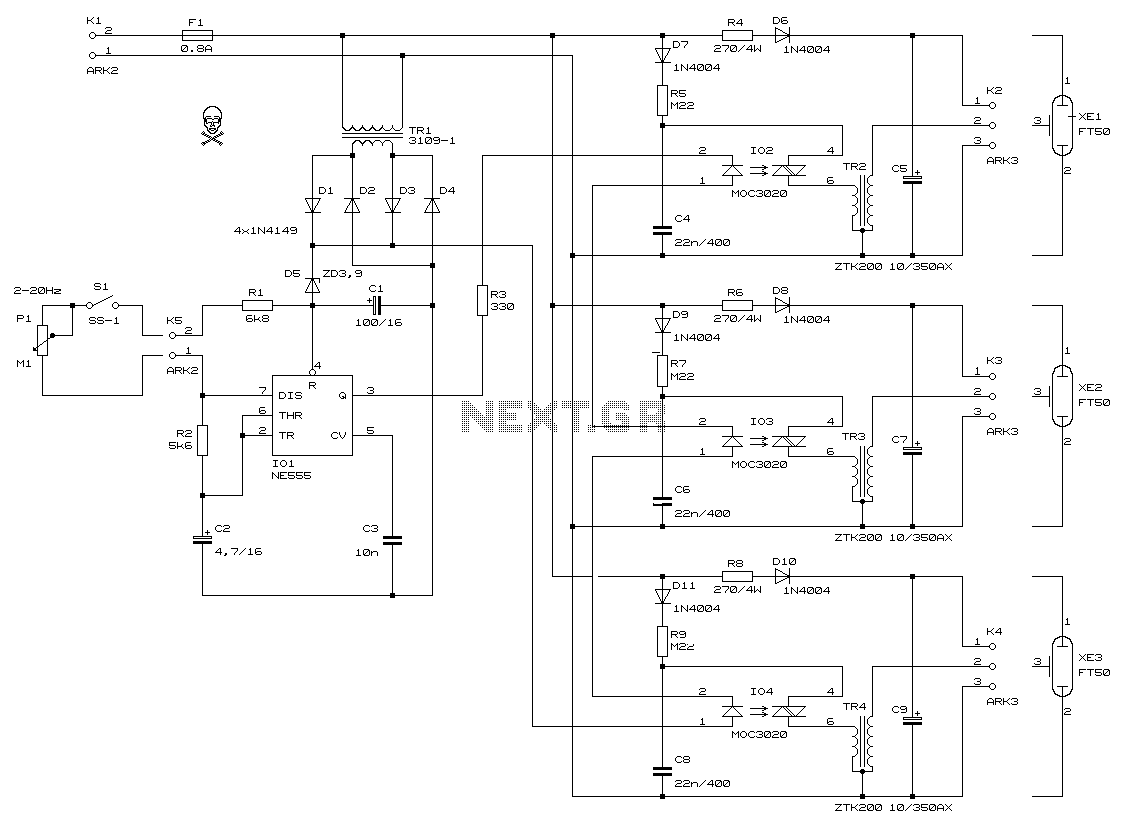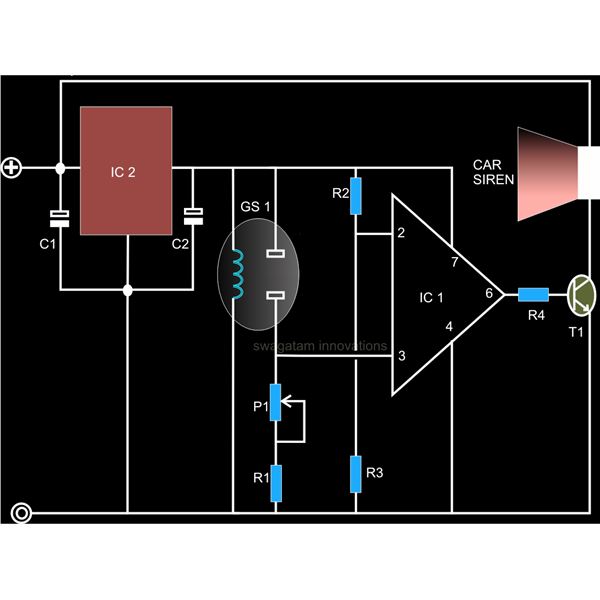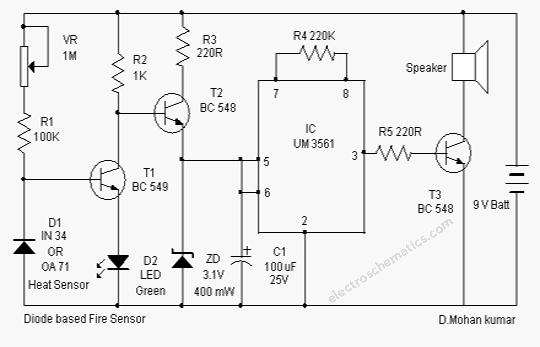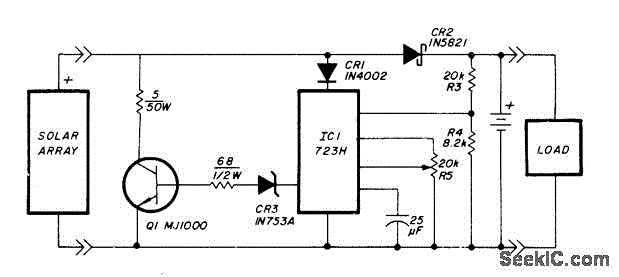
Overload speaker protection circuit
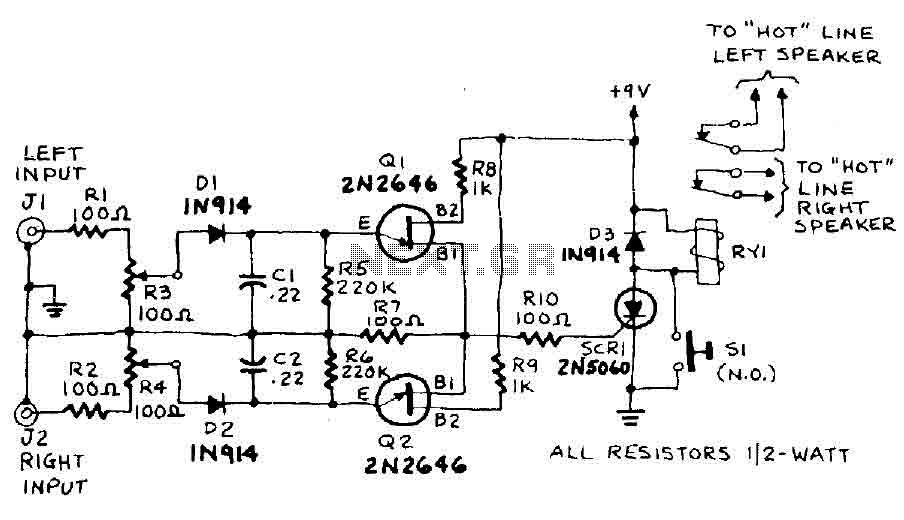
The circuit input is derived from the terminal loudspeaker or amplifier output jacks. If the right channel signal is sufficiently strong to charge capacitor C1 to a potential that exceeds the breakdown voltage of the emitter of transistor Q1, a voltage pulse will be generated across resistor R7. Similarly, if the left channel signal is strong enough to charge capacitor C2 to a voltage exceeding the breakdown voltage of the emitter of transistor Q2, a pulse will also appear across R7. This pulse triggers the sensitive silicon-controlled rectifier (SCR) SCR1, which has a gate-trigger current (IGT) of less than 15 mA, causing it to enter a latched conducting state and activate relay RY1. The operation of the relay interrupts the speaker circuit, resulting in silence, which serves as an alert for the issue. To reset the circuit and restore normal operation, the amplifier volume should be reduced, followed by pressing and releasing switch S1. The circuit can be configured to activate at any power level between 15 watts RMS and 150 watts RMS. Calibration involves deliberately overdriving the signal at the input of the right speaker protection and adjusting potentiometer R3 until relay RY1 activates. The same procedure is applied to the left channel, with potentiometer R4 being adjusted accordingly. After calibration, the circuit is ready for use.
The circuit operates as a protective measure for audio amplifiers and loudspeakers, ensuring that excessive power levels do not damage the connected components. The use of capacitors C1 and C2 allows for the detection of potentially harmful signals from both the right and left audio channels. The voltage pulses generated by these capacitors when charged beyond their respective thresholds are crucial for activating the SCR, which serves as a reliable electronic switch.
Relay RY1 plays a pivotal role in this circuit. When triggered by the SCR, it opens the circuit to the loudspeakers, effectively silencing them and preventing any further damage from excessive power. The incorporation of a reset switch (S1) ensures user control over the system, allowing for a manual reset after an over-power condition has been detected.
Calibration is a critical step in the setup process, as it ensures that the circuit responds appropriately to the specific characteristics of the audio amplifier being used. By adjusting the potentiometers R3 and R4, users can fine-tune the sensitivity of the circuit to match the output capabilities of their amplifiers, providing flexibility for different systems. This feature enhances the circuit's usability across a range of audio equipment, making it a versatile solution for speaker protection.
Overall, this circuit design exemplifies a practical approach to safeguarding audio equipment, combining simple yet effective components to create a reliable protective mechanism against over-power conditions.The circuit input is taken from the terminal loudspeaker or amplifier output jacks. If the right channel is large enough to charge C1 to a potential which exceeds the breakdown voltage of the emitter of Ql, a voltage pulse appears in R7. Similarly, if the left channel signal is large enough to charge C2 to a voltage that is greater than the breakdown voltage of the emitter of Q2 ", a pulse appears in R7.
The pulse triggers in R7 5CRI. A door sensitive SCR (LGT less than 15 RNA or IGT is the gate-trigger current) that locks in a conducting state and energizes Ryl. The action of the relay will interrupt the speaker circuit. and silence follows you must alert on the problem. Reduce the volume on your amplifier, then press and release 51 to reset the circuit and restore normal operation. The circuit can be set to go off at any level of 15 watts RMS to 150. To calibrate . deliberately over-power signal at the entrance of the right speaker protection and adjust R3 until RY1 boosts.
Do the same with the left channel, this time adjusting R4. The circuit is now calibrated and ready employment.
The circuit operates as a protective measure for audio amplifiers and loudspeakers, ensuring that excessive power levels do not damage the connected components. The use of capacitors C1 and C2 allows for the detection of potentially harmful signals from both the right and left audio channels. The voltage pulses generated by these capacitors when charged beyond their respective thresholds are crucial for activating the SCR, which serves as a reliable electronic switch.
Relay RY1 plays a pivotal role in this circuit. When triggered by the SCR, it opens the circuit to the loudspeakers, effectively silencing them and preventing any further damage from excessive power. The incorporation of a reset switch (S1) ensures user control over the system, allowing for a manual reset after an over-power condition has been detected.
Calibration is a critical step in the setup process, as it ensures that the circuit responds appropriately to the specific characteristics of the audio amplifier being used. By adjusting the potentiometers R3 and R4, users can fine-tune the sensitivity of the circuit to match the output capabilities of their amplifiers, providing flexibility for different systems. This feature enhances the circuit's usability across a range of audio equipment, making it a versatile solution for speaker protection.
Overall, this circuit design exemplifies a practical approach to safeguarding audio equipment, combining simple yet effective components to create a reliable protective mechanism against over-power conditions.The circuit input is taken from the terminal loudspeaker or amplifier output jacks. If the right channel is large enough to charge C1 to a potential which exceeds the breakdown voltage of the emitter of Ql, a voltage pulse appears in R7. Similarly, if the left channel signal is large enough to charge C2 to a voltage that is greater than the breakdown voltage of the emitter of Q2 ", a pulse appears in R7.
The pulse triggers in R7 5CRI. A door sensitive SCR (LGT less than 15 RNA or IGT is the gate-trigger current) that locks in a conducting state and energizes Ryl. The action of the relay will interrupt the speaker circuit. and silence follows you must alert on the problem. Reduce the volume on your amplifier, then press and release 51 to reset the circuit and restore normal operation. The circuit can be set to go off at any level of 15 watts RMS to 150. To calibrate . deliberately over-power signal at the entrance of the right speaker protection and adjust R3 until RY1 boosts.
Do the same with the left channel, this time adjusting R4. The circuit is now calibrated and ready employment.
